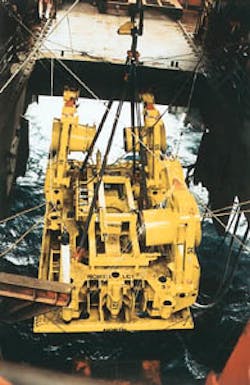Deepwater template employs central guide post for seabed installation
A deepwater version of Kongsberg's hinge-over subsea template (HOST), which is installable through a drilling rig moonpool, has now been developed.
KOS training centre
In February the doors of the KOS Training Center in Bergen opened for the first time. Here the company will train new employees, in classes of 14 at a time, in the skills of the subsea service engineer. The course comprises 12 weeks of concentrated learning, theoretical and practical, accompanied by exams. The trainee engineers are then attached to one of KOS's offshore crews to gain on-the-job experience.
These are busy times for KOS, as they are for many other Norwegian offshore companies. From end 1995, when the company had 336 permanent employees and a further 85 on contract, the numbers have grown fast to a total of 415 staff and 226 on contract in late January 1997.
The shortage of skilled personnel is such that the company is now looking to recruit abroad. And if the Centre proves a success, as seems likely, it may well offer to extend training to its customers' employees.
Kongsberg Offshore (KOS) has chosen OTC to launch the deepwater version of its HOST-based subsea production technology. It sees the deepwater version, which is intended for installation in depths of up to 2,500-meters, as the key to its entry into the deep waters of the Gulf of Mexico.
The KOS subsea technology is based on the Hinge-Over Subsea Template (HOST), a cost-efficient system of standard modules with standard interfaces which can be assembled in different configurations to suit the requirements of particular installations. Each of the modules or "building blocks" weighs under 25 tons and is installable through the moonpool of a drilling rig.
For deepwater applications, the company has now developed a guidelineless version of HOST. This entails the use of a central guide post for the installation of the template itself, while a funnel-down arrangement is used to land the xmas trees on the template. Otherwise the system is largely unchanged from the guideline version. The centre section and foundation parts, for example, are the same.
The guidelineless concept, and particularly the centering system, will be verified this summer through onshore and offshore tests, after which the company will offer it for future projects.
According to marketing manager Ingmar Nyheim, it is probably safe to assume that the guidelineless version will eventually replace the guideline version and become the standard version, in shallow as well as deep waters.
KOS keeps in close touch with customer needs through a 1994 technology agreement with Statoil, which Elf, Mobil and Shell have since joined. So far, some NKr 110 million has been invested in this programme. It is no coincidence, Nyheim says, that all the client companies have interests in deep-water prospects in West Africa.
Through its frame agreement with Statoil for the provision of subsea facilities, KOS has already received call-offs to the value of $500 million, according to Nyheim. These include Åsgard, to which it is supplying 16 HOST templates, Gullfaks Satellites (eight templates), Lufeng and Connemara.
Nyheim is keen to stress the flexibility of the HOST concept. While the standard HOST template accommodates four wellheads, it can be adapted to take five if necessary, and this is the case on Lufeng. The centre section of the template system was installed last December in significantly less time than planned, he says. The Lufeng contract was won in competitive bidding, though it now comes under the frame agreement with Statoil.
Off-template trees can also be accommodated. This will be the case in the second-phase development of Mobil's Zafiro Field in Equatorial Guinea, for which KOS is supplying three HOST systems, to which a number of satellite trees will be tied back. The only modification required is the replacement of the guide-base with a porch element for pulling in the flowline.
While KOS is a turnkey supplier of subsea facilities in its won right, it is also an important part of the turnkey delivery capability of its owner, FMC. The Zafiro order was won through FMC.
It is also through the joint FMC/KOS involvement in the Grand Banks Alliance that KOS has won work for PetroCanada's Terra Nova development, to which it is to supply about seven HOST templates. These will be installed in glory holes to protect them from ice scour.
FMC has also opened KOS's way into Brazil, where it has recently won orders to supply electro-hydraulic control systems to Petrobras for the Hercules and Marlim projects. In both cases it will be working closely with CBV, FMC's Brazilian partner and licensee.
Copyright 1997 Oil & Gas Journal. All Rights Reserved.
